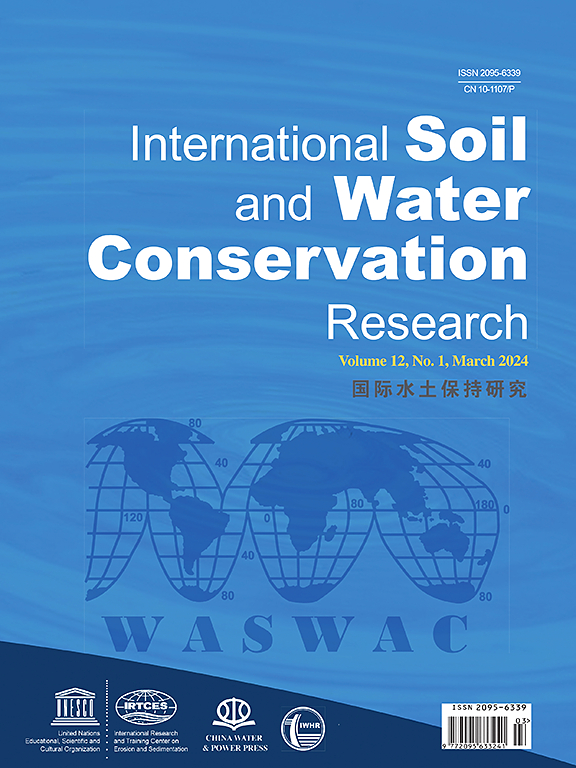IF 7.3
1区 农林科学
Q1 ENVIRONMENTAL SCIENCES
International Soil and Water Conservation Research
Pub Date : 2025-05-23
DOI:10.1016/j.iswcr.2025.05.009
引用次数: 0
摘要
本研究旨在阐明冻融循环在工程建设人为干扰下对高寒干旱河谷裸露坡面土壤侵蚀过程的影响机制。以坡度为20°和40°的裸坡为研究对象,通过室内人工降雨试验,分析了冻融循环对径流和产沙的影响。研究结果表明,与未冻结的斜坡相比,冻融循环后土壤飞溅的数量增加了大约三倍;坡角为20°和40°时,冻融循环后累积产流量分别减少15.99%和37.42%;当坡角为20°和40°时,冻融循环后的累积出砂量分别增加了2.29%和51.24%。在冻融边坡和非冻融边坡上,产砂速率在产流开始后迅速上升,分别在10 min和12 min达到1.34 g m−2·min−1和1.52 g m−2·min−1的峰值。冻融循环后,产沙速率趋于稳定,冻融斜坡的产沙速率大于未冻融斜坡。这些研究结果将为裸地管理和建筑干扰后生物环境的保护和恢复提供重要参考。本文章由计算机程序翻译,如有差异,请以英文原文为准。
Disparity in soil erosion processes between freeze-thaw and unfrozen slopes under artificial rainfall conditions in high-altitude and dry valleys of the Southeast Tibet region
The arid valley region in southeastern Tibet exemplifies an ecologically vulnerable area in southwestern China, where soil erosion has intensified in recent years as a consequence of socio-economic growth and infrastructure construction. This study aimed to elucidate the mechanism by which freeze-thaw cycles affect soil erosion processes on the bare slopes of this alpine arid valley region under artificial disturbances from engineering construction. Focusing on bare slopes with inclinations of 20° and 40°, we analyzed the impact of freeze-thaw cycles on flow and sand production through indoor artificial rainfall experiments. The findings indicated an approximately threefold increase in soil splattering following the freeze-thaw cycle compared to unfrozen slopes; cumulative flow production exhibited a declining trend, decreasing by 15.99 % and 37.42 % after the freeze-thaw cycle at slope angles of 20° and 40°, respectively; cumulative sand production increased by 2.29 % and 51.24 % after the freeze-thaw cycle at slope angles of 20° and 40°, respectively. On the freeze-thaw and unfrozen slopes, the sand production rates escalated swiftly following the initiation of flow production, reaching peaks of 1.34 g m−2·min−1 and 1.52 g m−2·min−1 in 10 min and 12 min, respectively. Post the freeze-thaw cycle, the rates stabilized, with the sand production rates on the freeze-thaw slopes exceeding those on the unfrozen slopes. These findings will serve as a significant reference for the management of bare ground surfaces and the conservation and restoration of biological environments following construction disturbances.
求助全文
通过发布文献求助,成功后即可免费获取论文全文。
去求助
来源期刊

International Soil and Water Conservation Research
Agricultural and Biological Sciences-Agronomy and Crop Science
CiteScore
12.00
自引率
3.10%
发文量
171
审稿时长
49 days
期刊介绍:
The International Soil and Water Conservation Research (ISWCR), the official journal of World Association of Soil and Water Conservation (WASWAC) http://www.waswac.org, is a multidisciplinary journal of soil and water conservation research, practice, policy, and perspectives. It aims to disseminate new knowledge and promote the practice of soil and water conservation.
The scope of International Soil and Water Conservation Research includes research, strategies, and technologies for prediction, prevention, and protection of soil and water resources. It deals with identification, characterization, and modeling; dynamic monitoring and evaluation; assessment and management of conservation practice and creation and implementation of quality standards.
Examples of appropriate topical areas include (but are not limited to):
• Conservation models, tools, and technologies
• Conservation agricultural
• Soil health resources, indicators, assessment, and management
• Land degradation
• Sustainable development
• Soil erosion and its control
• Soil erosion processes
• Water resources assessment and management
• Watershed management
• Soil erosion models
• Literature review on topics related soil and water conservation research
 求助内容:
求助内容: 应助结果提醒方式:
应助结果提醒方式:


